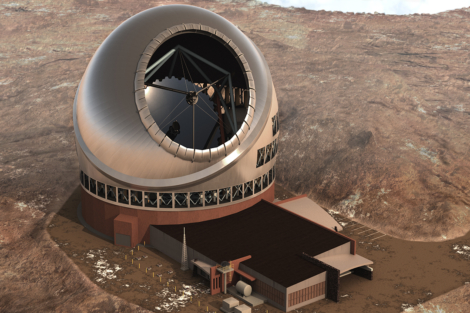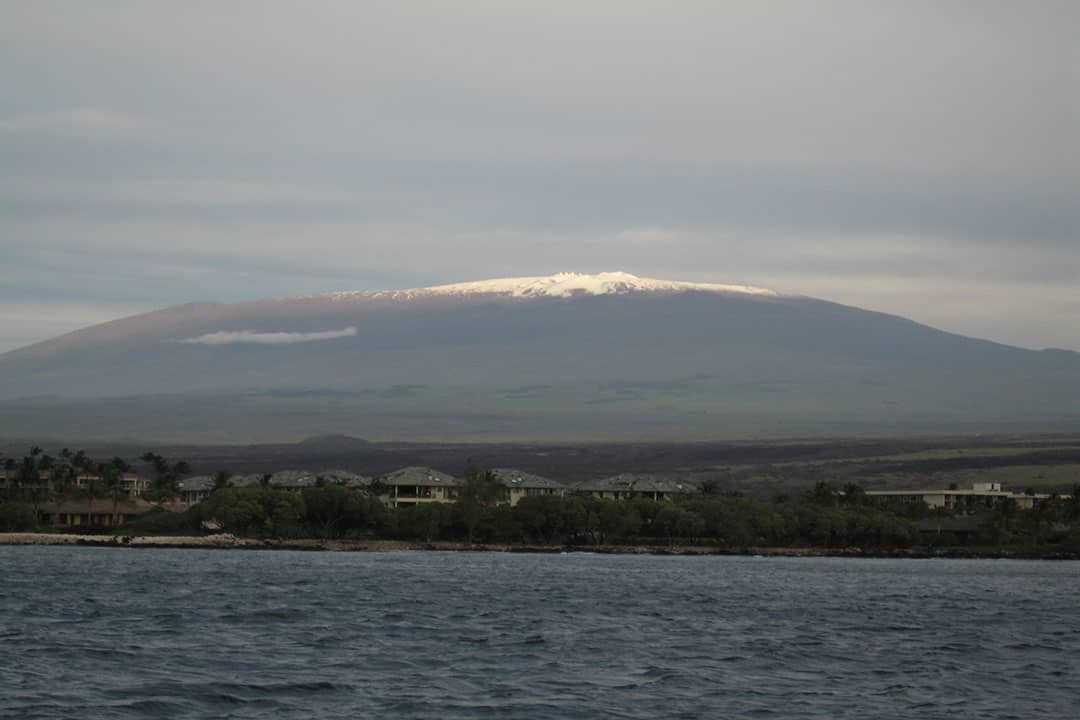Protests in Hawaii against the construction of the Thirty Meter Telescope (TMT) on the Mauna Kea — a sacred mountain that Native Hawaiians, known as Kānaka Maoli, regard as their origin site — have made their way to U of T. The university is a member of the Association of Canadian Universities for Research in Astronomy (ACURA), an organization that has funded the astronomy project.
U of T faculty and students criticized U of T’s involvement in the project, in solidarity with peaceful Kānaka Maoli protesters who have been occupying the site since construction began on July 15.
Astronomy’s rising star?
The TMT is a project over 10 years in the making, with the promise of enabling astronomers to look far into the past of stellar and galactic evolution. With an area nine times bigger than any existing visible-light telescope, the TMT is designed to identify images with unprecedented resolution, surpassing even the Hubble telescope.
The profound sensitivity of the TMT boasts the potential for observational data to answer questions about “first-light” objects, exoplanets, and black holes in the centre of galaxies.
This potential for furthering astronomy and astrophysics is what makes the TMT astronomy’s rising star.
Why is the TMT being protested?
In July 2009, the Board of Governors for the TMT chose the Mauna Kea as its location. Mauna Kea has long been an astronomical hotspot, serving as the location for 13 observatories. The TMT would be the 14th, standing as the biggest telescope on the mountain.
Mauna Kea is a sacred ancestral mountain, a place imbued with both natural and cultural resources. It is the location of many religious rituals conducted by the Kānaka Maoli, as well as a burial ground of sacred ancestors. Additionally, its ecological value is profound, housing esoteric ecosystems and providing water to the residents of Hawaii.
For these reasons, native kia’i (guardians) and kūpuna (elders) have resisted industrialization on Mauna Kea ever since the first telescope was built in 1968.
Subsequently, the TMT has attracted significant protests, serving as the Leviathan of telescopes. Dr. Uahikea Maile, Assistant Professor of Indigenous Politics at U of T, describes the TMT as a “unique beast” because of its size and location.
The project requires eight acres on the northern plateau of the mauna, which is currently untouched. Maile asserts that the corporation backing the TMT tempts the State of Hawaii into “valuing techno-scientific advances and alleged economic benefits over Native Hawaiian rights and the environment.”
Hence, ever since 2014, kia’i have attempted to halt the construction of the TMT by forming blockades at the base of the summit.
A brief space-time log of events
On July 10, Hawaiian Governor David Ige announced that construction of the TMT would begin on July 15, 2019. Five days later, hundreds of peaceful protestors stood together to form a blockade that would prevent construction crews from ascending Mauna Kea to begin constructing the TMT.
Located at an elevation of 6,000 feet, the blockade is logistically supported by the Pu‘uhonua o Pu‘uhuluhulu, a place of refuge providing resources and infrastructure to sustain all those involved in the blockade, wrote Maile. All people at the pu‘uhonua have access to free housing, food, health care, child care, and transportation.
Maile, who is of Kānaka Maoli descent, spent two and a half weeks at the protests. He recounted that the kia’i were “constantly prepared for the risk of police force and violence.” On the second day of protests, Governor Ige deployed the National Guard, militarizing the once peaceful site of protest.
On July 17, police arrived at the scene carrying riot batons, tear gas, guns, and a Long Range Acoustic Device, according to Maile. The elder kūpuna, many of whom were in their 70s or 80s, formed the central blockade, while they requested the kia’i to stand at the sides of the road.
Thirty-eight people were arrested at the scene, most of whom were kūpuna, but after hours of negotiations “a deal was struck and all police left.”

Numerous sources maintain that U of T’s statement on the Thirty Meter Telescope (artist’s depiction pictured) are not reflective of the views of all faculty members and students.
Courtesy of TMT Observatory Corporation
University of Toronto responds
U of T, a member of ACURA, is involved in the TMT.
It is important to note that U of T is not directly invested in the TMT. Nonetheless, Professor Vivek Goel, a board member of ACURA and Vice-President, Research and Innovation, and Strategic Initiatives at U of T, published an official statement explaining that he has been “watching closely the recent events at the construction site.”
He continued by writing that U of T “does not condone the use of police force in furthering its research objectives,” and noted that the university’s commitment to truth and reconciliation impels it to consult with Indigenous communities.
Lack of consensus amongst faculty members
U of T’s official statement has received backlash from numerous sources who maintain that it is not reflective of the views of all faculty members and students.
For instance, Dr. Eve Tuck, an Associate Professor in the Department of Social Justice Education, has written three letters to U of T President Meric Gertler, criticizing the statement for not going far enough in taking action against the TMT.
In an email to The Varsity, Tuck wrote that while the university has no direct funding in the TMT, there are still ways to divest. “There is more than money that can and should be withdrawn in this situation, including support, endorsement, affiliation, reputational backing, approval, and advocacy for the project.”
She believes that it is imperative for U of T to prevent the TMT’s construction, and if it does not do so, it “is on the wrong side of history.”
Moreover, protesters of the TMT have found an unexpected ally in some astronomers who, perhaps counterintuitively, oppose the project. For instance, Dr. Hilding Neilson, an Assistant Professor at U of T’s Department of Astronomy & Astrophysics, wrote that “the statement from the university doesn’t say a whole lot.”
He specifically questioned the statement’s assumption that astronomy has a “moral right” to the mountain because it is a scientific field, which supposedly seeks to benefit the accumulation of knowledge for all of humanity.
Power to graduate students
An open letter authored by astrophysics graduate students at the TMT’s partner institutions reinforced this opposition from U of T astronomy professors. The letter, published online, called on the astronomy community to “denounce the criminalization of the protectors on Maunakea” and to remove the military and police presence from the summit.
Two signatories, Melissa de los Reyes and Sal Wanying Fu, wrote to The Varsity that it is “imperative for the astronomy community to denounce [the arrests of kūpuna] and take a stand against the further use of violence in the name of science.”
Reyes is a second-year graduate student at the California Institute of Technology, while Fu is an incoming graduate student at UC Berkeley. Both are National Science Foundation graduate fellows.
The open letter was published despite the risk that it could potentially impact the signatories’ research careers. The signatories include graduate students, postdoctoral researchers, and professors.
Signatories from U of T include professors Hilding Neilson and Renee Hlozek, Postdoctoral Fellow John Zanazzi, Sessional Instructor Dr. Kristin Cavoukian, PhD students Fergus Horrobin, Fang Xi Lin, Marine Lokken, Adiv Paradise, and Emily Tyhurst, and undergraduate students Yigit Ozcelik, Andrew Hardy, and Rica Cruz.
Jess Taylor, the Chair of CUPE 3902 and a writing instructor in the Engineering Communication Program at U of T, was also a signatory.
The signatories Reyes and Fu hope that the discussion prompted by the letter causes academic astronomers to “reckon with the ways in which social systems are inextricably linked with the way we do science.”
Neilson commended the bravery of its signatories, writing that “for students to come out and do this, potentially not only against their own research, but against their supervisors’ and departments’ requires standing up to power.”
Activism by undergraduate students
The University of Toronto Students’ Union (UTSU) and the Indigenous Studies Students’ Union (ISSU) also published a joint statement on August 29 condemning the construction of the TMT at Mauna Kea.
The UTSU represents full-time undergraduate students at the St. George campus, while the ISSU’s membership includes students who are enrolled in the Indigenous Studies program or are taking at least one Indigenous Studies course.
The unions called upon U of T to “cease construction” of the telescope and to relocate it to an “area where its construction would not infringe upon the sacred land of Indigenous peoples or damage land that is environmentally protected.”
Eclipsing Indigenous knowledge
It is important to recognize that the Kānaka Maoli protests are not against science. Rather, they are against a Western ideology of economic development that — in the name of science and objectivity — has historically propagated mechanisms of colonization, slavery, and incarceration. Following centuries of colonial and postcolonial development, the scientific industry today undermines and maligns Indigenous knowledge systems — associating it with primitivity.
Meanwhile, Neilson draws attention to the value of Indigenous knowledge, stating that “a lot of the tensions between Hawaiians and TMT come from the fact that a lot of us are ignorant of Hawaiian knowledge, and what it means for Mauna Kea to be sacred.”
Ultimately it is not a question about science versus culture, but about whether development under the guise of science reinforces a certain hierarchy of culture. It is evident that there is a need for a scientific Big Bang, one where Indigenous cultures is no longer at the bottom of this hierarchy.


